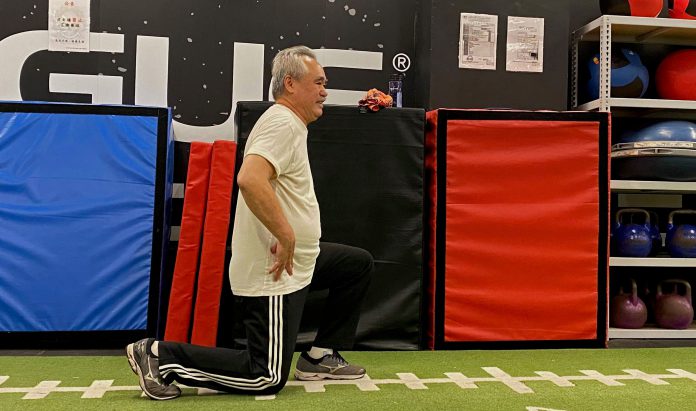Middle-aged and elderly people do strength training to slow down the ageing process and improve their quality of life.
By Linn Wu in Taipei
At 6 a.m., Jenny Chen, 63, walks into a gym where a few young adults are exercising.
“I invest in my health. I have been exercising for about 30 years, mostly swimming and jogging. To avoid muscle loss and body aches when I get older, I began strength training three years ago to stay in shape and preserve my muscles,” the businesswoman says.
Ageing Research Reviews in 2018 reported people lose almost 10 per cent of muscle mass every decade from middle age.
Chen trains every morning before work, alternating between strength training and cardio workouts.
“I started exercising for better recovery after giving birth. I was highly stressed at work and often woke up feeling upset. A morning workout always cheers me up and helps me stay fresh in the office,” she says.

“Strength training is good for my everyday life. It teaches me how to improve my posture and prevent a back strain. Ballroom dancing becomes easier too. Strong core and leg muscles allow my upper body to move more freely. I can even sing higher notes now,” Chen adds.
Although Chen often encourages her friends who are also in their sixties to exercise, they lack motivations.
“Many fear workout injuries. In the past, people thought strength training meant lifting heavy weights. But we actually start with a light load and build it up progressively. There is a risk of injury in whatever sports you do,” Chen says.
“Many friends in my age rarely exercise. They even consider walking exhausting, let alone training. My lady friends would rather cover their bingo wings instead of improving them,” she says.
“Many friends in my age rarely exercise. They even consider walking exhausting, let alone training.”
To enhance physical function and reduce the risk of falls, the U.S. Centres for Disease Control and Prevention (CDC) in September, 2020 advised adults aged over 65 to do multicomponent physical activity which includes balance training, aerobic activity, and muscle-strengthening activities on a weekly basis.
Yang Yijian, an expert on physical activity in ageing and assistant professor of the Department of Sports Science and Physical Education at the Chinese University of Hong Kong, says that strength training cannot be replaced by aerobic exercise.
“We need to maintain muscle strength to perform daily activities,” Yang says, adding that running and biking are not as beneficial to strength as resistance training such as lifting weights. “Strength training improves our control of movements,” he says.
“Strength training improves our control of movements.”
Yang points out falls are common among seniors.
“About 30 per cent of older adults living at home and over half of those staying in nursing homes fall at least once a year. Possible injuries from falls include a hip fracture which can cause severe complications such as loss in mobility and death,” he says.
According to the Department of Household Registration Affairs in Taiwan in 2019, more than 3.6 million citizens were above 65 years old, accounting for 15 per cent of total population.
The Census and Statistics Department in Hong Kong reported there were more than 1.3 million seniors in mid-2020, making up 18.3 per cent of the city’s population.
Yang says muscle strength enables people to protect themselves and minimise the risk of injury.
“When people with enough strength lose balance, they can avoid bumping their heads by taking a step forward or putting hands on the floor first. But we found many protective responses in falls ineffective due to a lack of muscle strength,” Yang explains.
“Resistance training also strengthens bone density and that reduces vulnerability to fractures,” he adds.
Lee Li-chun, 52, joined a gym three years ago when she suffered from menopause discomfort such as anxiety. She tried strength training nine months later in hope of improving her back pain.

“I realised that I need to train and stay strong to support myself, or no one will take care of me,” Lee says. The homemaker had to use a wheelchair when she first threw her back out two years ago.
“My lower back used to be so stiff in the morning that I walked slowly to the washroom with my hands on a wall like a zombie,” Lee says.
Her situation improves after more than a year of training. “Only one can save oneself. If you don’t exercise, no one can help,” she adds.
“Only one can save oneself. If you don’t exercise, no one can help,” she adds.
Her situation improves after more than a year of training. “Only one can save oneself. If you don’t exercise, no one can help,” she adds.
“Only one can save oneself. If you don’t exercise, no one can help.”
Lee does resistance and aerobic training five days a week as she understands progress takes time and effort.
“My body conditions may be almost the same as others in my age. But the differences will be huge five to eight years later when we approach our sixties. Those who never work out will age quickly and suffer from body pain while I can manage to stay in a better shape,” she says.
Although Lee acknowledges the benefits of strength training, they do not come cheap.
“Money is a big issue. Hiring a coach is necessary for one to train safely and constantly,” Lee says. She pays for 80 training sessions with NT $1,550 (US $54) each and her gym membership costs more than NT $1,000 (US $35) a month.
“There is no return for me. I will find a gym wherever I go and keep exercising, with or without a trainer,” Lee says.
Ted Ho, 68, shares Lee’s view. The retired businessman hurt his back during exercise in his twenties and had suffered from the pain for more than ten years. But he gives strength training a second try.
“My back became weaker after the injury, so I use a leg press machine instead of squatting with a bar on my back,” he says.
Ho took strength training classes for six months from late last year to early this year and learned alternative exercises such as lunges.

“I never challenge my capacity. I exercise merely to maintain muscle strength and prevent muscle soreness after doing household chores,” says Ho, who lives alone and has been training for more than seven years.
Chou Chi-feng, a 32-year-old private trainer, has coached more than 10 seniors aged from 65 to 77 years.
He finds most of his clients start training too late. “In the first session, some could not even do two sets of squats with 10 times each without bearing any weight,” he says.
Chou thinks it is important to help the elderly build confidence as they fear heavy training loads and exercise injuries.
“I always assure them the weights are within their capacity to give them a sense of security,” he says. Chou usually provides additional assistance such as handles in the first few tries and removes it later.
According to CDC, even if one has problems doing normal daily activities, such as climbing stairs or walking, regular physical activity is still safe and good.
In response to common misunderstanding, Yang clarifies that strength training can be easily done at home. “Lifting heavy weights or doing high intensity training is not necessary,” he says.
Yang suggests people make use of water bottles, elastic bands, or stairs to train progressively.
“It’s never too late [to start exercising]. Even those up to 80 years old can still benefit from strength training.”
“You can hold on to a chair to prevent falls and do squats to train your lower limbs. To improve balance, you can try standing with one leg. It also trains your muscle strength if you hold the position longer,” he says.
Yang adds daily activities such as grocery shopping and cooking are also important for the elderly to maintain independence.
“It’s never too late [to start exercising]. Even those up to 80 years old can still benefit from strength training. Some research even shows people with frail bodies improve more,” Yang says.
Edited by Lasley Lui & Regina Chen







































